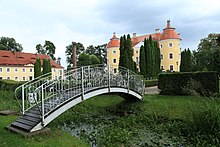Milkel Castle
The Castle Milkel stands in the same place Milkel in the Saxon district of Bautzen and is a baroque country castle in the Oberlausitz .
location
The complex of the Baroque Milkel Castle is located on the northern edge of the village of Milkel in the Radibor municipality . This is located about 13 kilometers north of Bautzen in the Upper Lusatian heath and pond landscape .
history
The castle, which is now surrounded on four sides by water, is founded on oak piles and was probably supplemented with stone buildings from 1302. A wooden defense and residential tower is said to have stood here as early as the 9th century . The finds of the oak foundation in 2005, with the felling date 1302, which are also exhibited in the castle courtyard, are the first evidence of the existence of old German moated castles on oak pile foundations in Upper Lusatia . From the 14th to the 18th century, the castle was expanded by the respective owners. In 1719/20 the von Ponickau family added the north tower and created the current basic shape. Since Moritzburg Castle was brought into its current form in 1724/25, it stands to reason that Milkel was the pilot project for Moritzburg .
Friedrich von Metzradt, named among the Budissin men as early as 1272 , founded the Milkel manor around 1300. The Milkel Church was built with him and his family in 1322. The Metzradt family resided in Milkel until 1595. From 1595 to 1617 it was the von Löben family ; from 1617 to 1640 the von Krahe family, 1640 to 1759 the von Ponickau family , 1759 to 1769 the counts of Gersdorf . The widow of the Saxon Minister Nicolaus Willibald Graf von Gersdorff (1713–1765), Eleonore Henriette b. von Ponickau (1733-1806), married in 1766 the second marriage to the cabinet minister Count Johann Georg von Einsiedel , who was enfeoffed with milk in 1769. It was then owned by Count Einsiedel auf Reibersdorf until 1908 . In 1908 the Landbank zu Berlin took over the property and sold it to the von Holnstein family , who extensively renovated the castle and lived there until it was expropriated in 1945.
From 1945 to 1948 it was used as a refugee camp, and from 1948 to 1953 the Free German Trade Union Federation trained its functionaries here on the basic issues of Marxism and Leninism. The Sorbian language school used the area from 1953 to 1993 . From 1993 to 1998 the castle stood empty, was viewed by 51 interested parties, but - although it was last offered for only 1 DM - it was not sold and due to the high repair backlog it was abandoned until a buyer was found in 1998 with the entrepreneur Hermann Fuchs. After 14 years of renovation work, the castle, the cavalier houses , the park and the burial grounds of the previous owners are in a monumental condition.
The attachment
The coats of arms of the former owners, those of von Zehmen , von Ponickau , von Haugwitz and von Einsiedel, were located above the portal door, the front windows and in the gable part of the central risalites . The timing of the sundial and all coats of arms were destroyed in GDR times because they were not compatible with political ideology. The sundial was restored in 2008, the stucco decoration in the gable in 2010.
Particularly noteworthy features inside are the cell vaults in the south tower from the period after 1400 and the stucco design (around 1750) on the ceiling of the rococo hall .
In the line of sight to the west, the symmetrical, French-style park section, which is equipped with sandstone sculptures and other decorative elements, can be seen on the ground floor. A sandstone bridge and the wrought iron bridge built on old ground in 2005 lead to the larger, English landscape park . The 16 groups of baroque and rococo figures that adorned both parks before 1945 were smashed and buried by commissioned persons in the 1950s. Parts of it were excavated during leveling work near the oil house in 2004, cleaned and exhibited in the castle. The English landscape park, criss-crossed by many paths, shows clear structures of Prince Pückler's park design . From the African tulip tree to ash maple to the local pedunculate oak and red beech there are many different tree species.
use
Today the castle is privately owned, the cavalier houses are rented. The park is open to visitors.
literature
- Dr. Helmuth Gröger: Castles and palaces in Saxony, Verlag Heimatwerk Sachsen, Dresden, 1940, article on Milkel Castle with illustration on page 164
Individual evidence
- ↑ a b Milkel Castle Administration
- ↑ Album of the manors and castles in the kingdom of Saxony III: Margrave Oberlausitz . Expedition of the album Sächsischer Rittergüter und Schlösser, Leipzig 1859. Online: SLUB Dresden
- ↑ a b State Office for Monument Preservation Saxony (homepage)
Web links
- Milkel Castle Oberlausitz , website of the castle
- Milkel in Gustav Adolf Poenicke (ed.): Album of the manors and castles in the Kingdom of Saxony, Volume 3: Markgrafenthum Oberlausitz, Leipzig 1859 at Wikisource
Coordinates: 51 ° 17 '59.1 " N , 14 ° 27' 38.9" E



